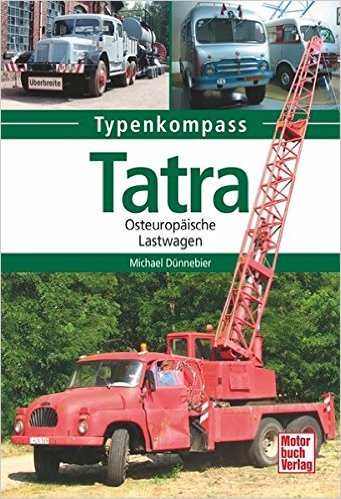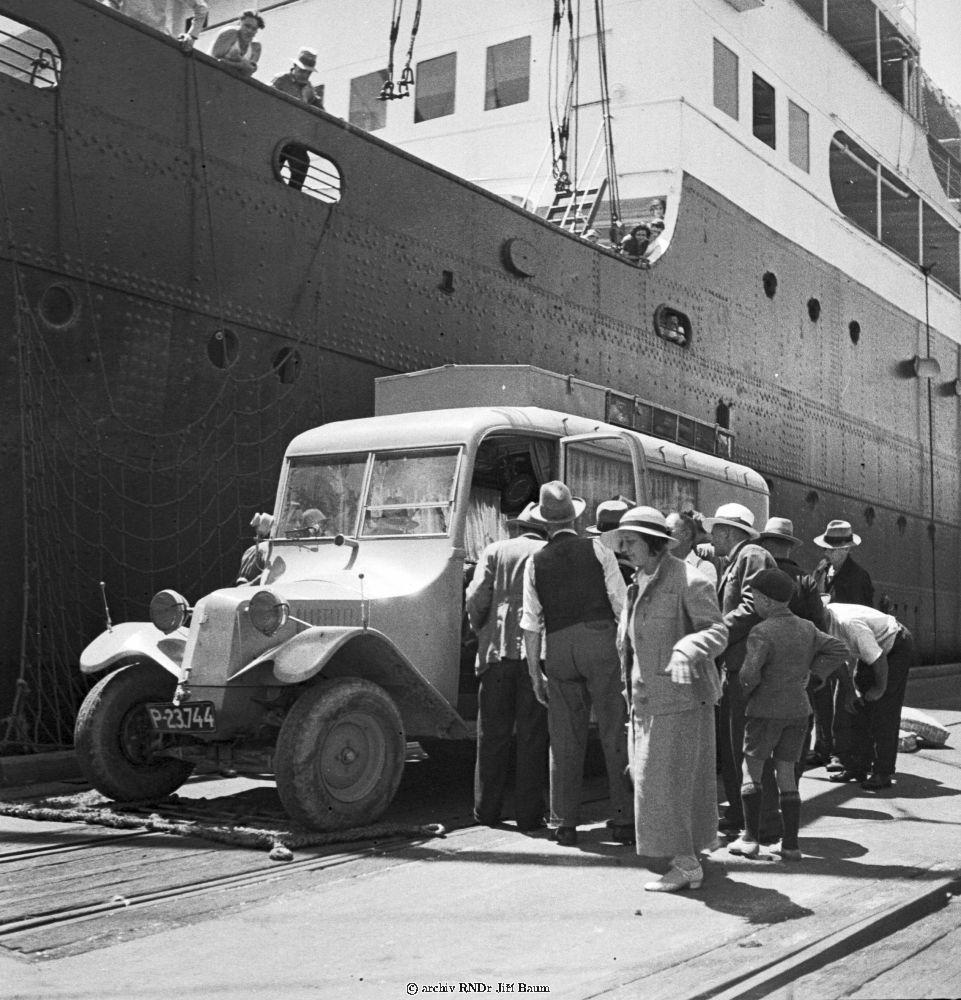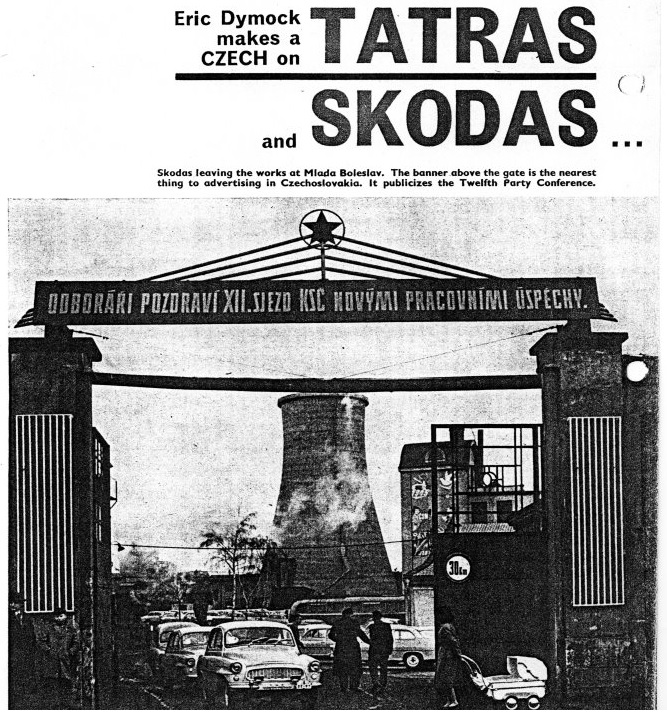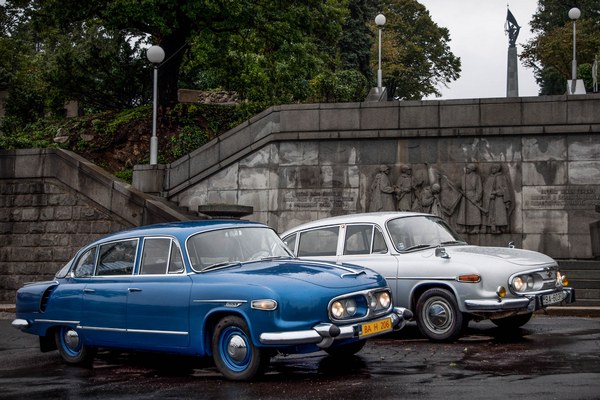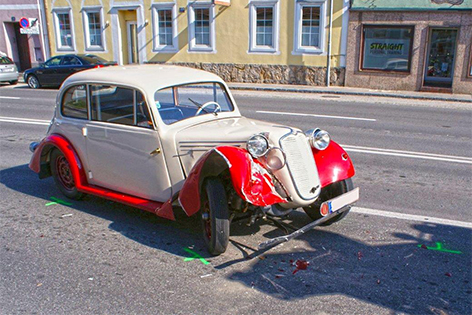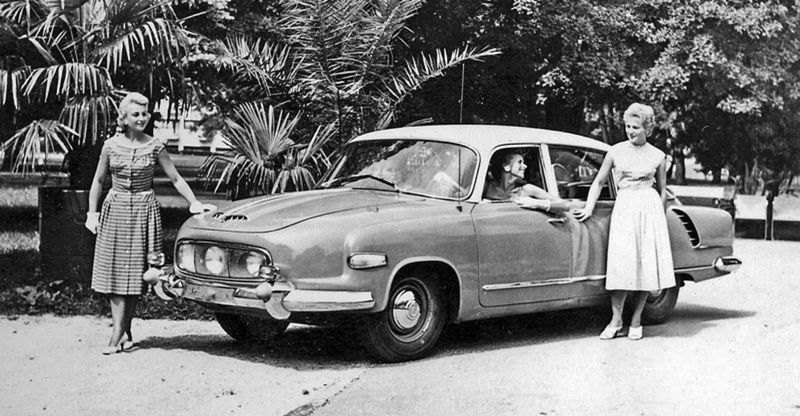
Although the prototype was created already in 1955, he witnessed the premiere of the legendary Tatra 603 to the International Engineering Fair in Brno in September 1956. In the politically challenging times rolled off the production lines three generations. Today, there are collector’s circles former papalášske limousine extremely valuable.
The history of the last truly aerodynamic sedan streamlined dates back to 1934, when he came to the market model 77. Later came Models 87, 97 and 600 Tatraplan. In the mid-50s appeared Tatra 603, but its development took place in secret. CMEA his family decided to limousines will be produced in Soviet factories GAZ and ZIS (ZIL later). Soviet limousine but did not meet the qualitative ideas Czechoslovak government.Although the prototype was created already in 1955, he witnessed the premiere of the legendary Tatra 603 to the International Engineering Fair in Brno in September 1956. In the politically challenging times rolled off the production lines three generations. Today, there are collector’s circles former papalášske limousine extremely valuable.
Vehicle manufacturing representative offices in 1954 legalized. Body was created from the collaboration of artist Francis Kardausa and designer Vladimir dustman. Air-cooled eight-cylinder fork F to 603 OHV constructed Julius Mackerle. It was an engine with a displacement of 2545 cm3 and 70 kW (95 hp). Maximum power and torque is at 4,800 rpm.
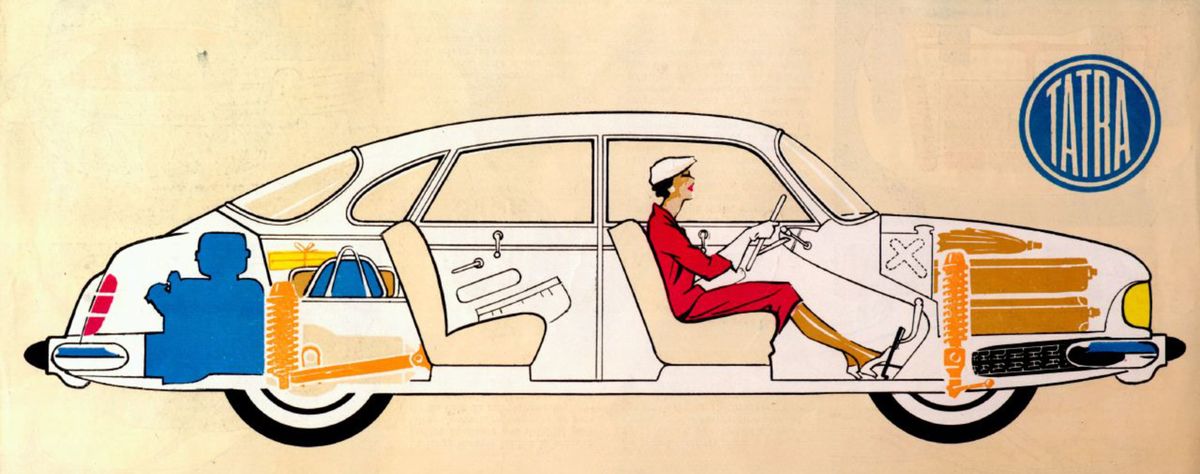
Tatra 603 had two luggage compartment. Bigger was located under the bonnet, a smaller rear seat.
Author: Tatra
Dimensions of the first generation of Tatra 603 was impressive. Was 5,065 mm long, 1,910 mm wide and 1,530 mm in height. Wheelbase 2750 mm will particularly great comfort for the rear passengers. With a ground clearance of 200 mm, the driver need not fear even more demanding terrain. Tatra 603 had two luggage compartment. Ten more are on the front and provide a 360-liter storage space. Smaller, with a capacity of 140 liters, he was hiding behind the rear seats.
The first generation was unique in several respects. It was probably the most typical feature of the trio of lights in the front grill. Tatra addition experimented with the possibility that the light in the middle of driving filmed, but serial production has not included this achievement.Trinity lights will not transfer to the next generations for the regulation ordering even number of headlamps which have to be symmetrical. When the Regulation entered into force, owners of older models and the first Tatra 603 had a light bulb in the middle removed and covered with a searchlight. Moreover, the first generation was determined for six passengers, as these have only five.With a weight of 1 470 kg is no need to wonder that it was not too nimble vehicle. According to technical data, the first generation of Tatra 603 accelerated from 0 to 100 km / h in 19 seconds. Nevertheless, the manufacturer indicates a maximum speed of 160 km / h. It is said that professional drivers, officials and civil servants were able to run the “180-kou”. Said parameter corresponds to the consumption data. For a standard driving Tatra 603 needed about 12.5 liters of fuel per hundred kilometers.
future generations
Tatra 603 cosmetic change almost every year. A significant change came in 1960, when 603 F engine replaced the aggregate 603 G. Displacement of the new power unit has been reduced to 2472 cm3, while power remained the same. The reason for the change was tabulated jurisdiction, as after the new Tatra 603 in the category “up to 2.5 liters.” The first fundamental changes to come in 1963, when she appeared marked the second generation 603-2 (in older literature T2-603). Trinity lights replaced the two pairs that were richly decorated with chromium addition. In addition, engineers widened track, redesigned dashboard and equipped brake booster. Last improving powerplant came a year later. Engine bearing 603 H provides a powerful 77 kW (105 hp).
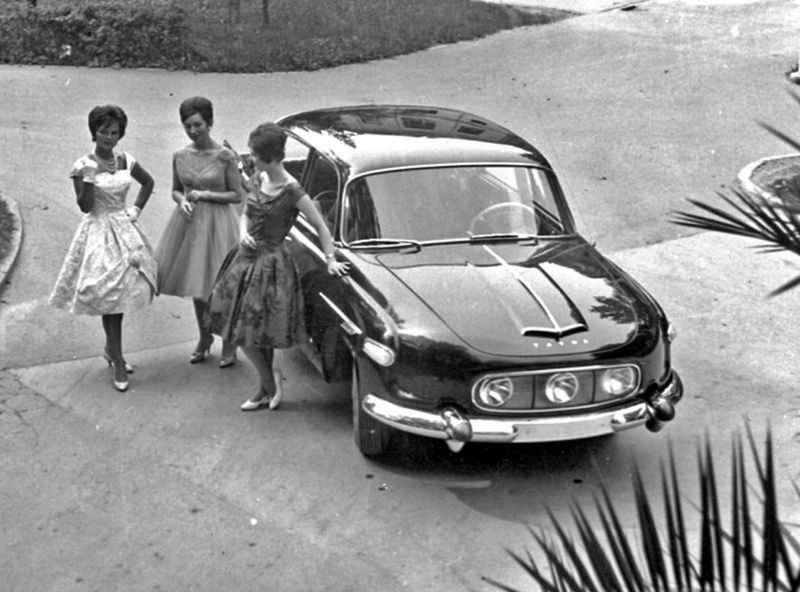
Trinity headlights comes first generation of Tatra 603 unique look. The following two series already had four front lights.
Author: Tatra
The third and final generation change saw the light of day in the fall of 1967. The vehicle was named Tatra 603-2 model 1968 modified bumpers body shortened the new mirrors it narrowed. The distance between pairs of headlamps widened. Integral front bench to replace two separate folding seats.Despite a weight of 1 510 kg vehicle is accelerated to a hundred in just 15 seconds. In the latest generation of assembled since 1970 disc brakes from Dunlop, and in 1973 began with a series assembly contactless electronic capacitor discharge ignition.

The interior of the second-generation model called Tatra 603-2.
Author: Tatra
Tatra 603 production ended October 25, 1975. For twenty years production rolled off production lines in Kopřivnice and later in Pribor 20,422 vehicles. Its successor became more angular Tatra 613 proposed by Vinagle body shop. For cult regarded as “603-ky” first generation. They owe a glitzy body and exceptional front grill. Of the 5,922 units produced but retains only a fraction.One of the main reasons was poor corrosion resistance of the body. He usually lasted ten years. The manufacturer shall provide a replacement, but only for a newer version.
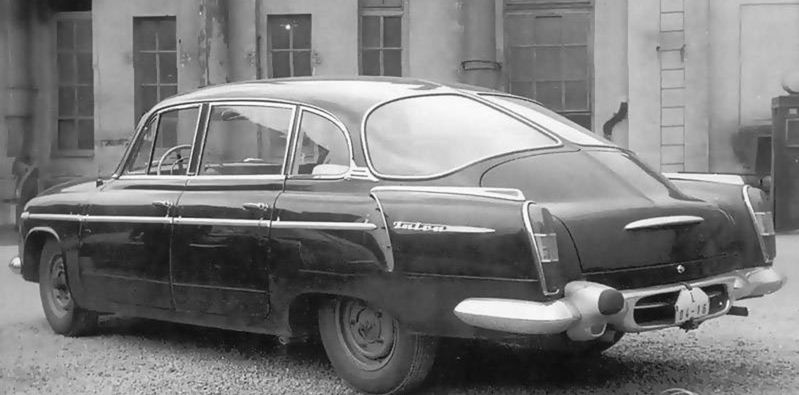
Tatra 603 was too expensive for ordinary people. Application found limousine as officials and civil servants.
Author: Tatra
Why you could ride in a Tatra 603 used mainly high-ranking dignitaries? For the first pieces were 95,000 crowns. In the 60s even become more expensive for 108,000 crowns and the last were astounding 195,000 crowns. For the current value, and it is high and likely to grow in time. Renovated 603 Tatra third generation starts at 10,000 euros. If you were interested in shipwrecks, also you will have to prepare a few thousand. Restored items first generation would you go out to a minimum of 35,000 euros.
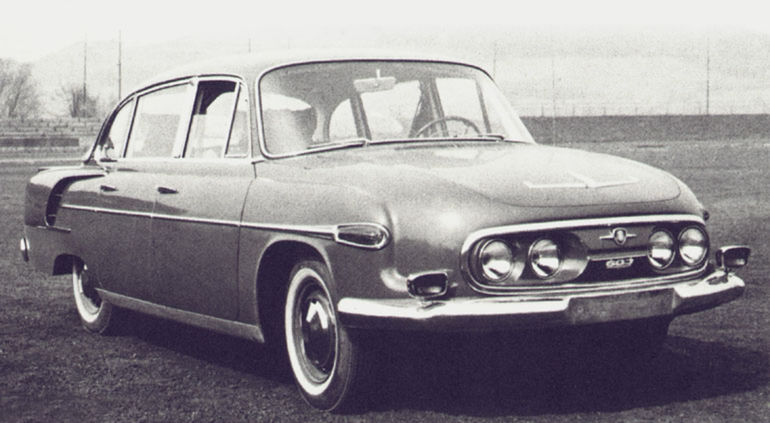
Tatra 603 body has been through twenty years of producing some modifications. Third generation (pictured) was even sold for twice the price of the first series.
Author: Tatra
Racing successes and prototypes
Specially modified Tatra 603 took part in several races. In addition to the Austrian Alpine Rally driving and Wiesbaden are racing specials with an output of 103 kW (140 hp) and a lighter bodywork also they presented the Endurance Marathon de la Route. Originally it was a long-distance rally, but later moved to the northern loop of the Nürburgring.
Unimaginable race lasted 84 hours, and in 1965 it Tatry ranked third and fourth place, one did not finish the race. A year later to start again built three vehicles, this time with an output of 110 kW (148 hp). The finish came at the third, fourth and fifth place and won the team competition. In 1967 they reached the finish only two of the three crew members, but those were placed fourth and fifth. Participation at the last riders raced on the modified version of the model, 1968.
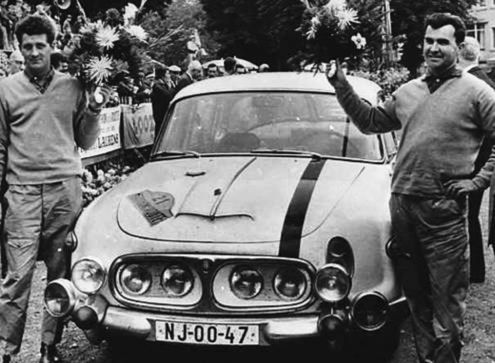
Zdeněk Čechmánek, Alois Mark and Tatra 2-603 after successful GT race in Marathon de la Route 1965, the GT is placed in 4th place.
Author: Tatra
Design prototypes based on Tatra 603 created several. The first was the Tatra 603 A version of sedan and station wagon in 1962. In 1964 it was followed by an ambulance, which was created in the Bratislava branch of Tatra led by Ivan Michiko. In addition, in Bratislava and prototypes built by 603 X minibus MB Low-Deck and platform floor. Tatra 603 has enjoyed a sports prototype. It was a coupe JK 2500, was the creator of designer Julius Kubinský. The original power unit of the car was Alfa Romeo unit, but later he replaced the engine T 603rd

The prototype low-floor systems Open NP was established in the Bratislava branch of the Tatra Mountains.
Author: Tatra
As for the colors and the Czechoslovak road it was possible only seeing black body. Promotional materials are not filled in the two-color combinations of vehicles, which were at that time extremely popular. But it is primarily intended for Western markets. Two white “603-ky” found a space in the garage of prominent personalities. One got the Shah of Iran Reza Pahlavi and the other Cuban leader Fidel Castro. In the latter case, the Tatra Castro odvďačila for American Chevrolet Corvair, which gave him and to which they would otherwise get. It is interesting that Castro copy of the only air conditioning.
Tatra 603 has enjoyed the modern processing of that care company Faurecia. In late 2007, he unveiled at the Los Angeles studio Premium Attitude. It was the concept of a modernized black Tatra 603 from 1972.
Size, volume, weight,
| version |
Tatra 603 |
Tatra 603-2 model 1968 |
| Length (mm) |
5065 |
4995 |
| Width (mm) |
1910 |
1910 |
| Height (mm) |
1530 |
1530 |
| Wheelbase (mm) |
2750 |
2750 |
| Clearance (mm) |
200 |
200 |
| Weight (kg) |
1470 |
1510 |
| Boot capacity (l) |
360 + 140 for the rear seats |
370 + 120 for the rear seats |
| Tank capacity (l) |
55 |
60 |
Technical specifications
| version |
Tatra 603 |
Tatra 603-2 model 1968 |
| engine Type |
petrol |
petrol |
| engine configuration |
to V |
to V |
| engine location |
at the back |
at the back |
| Displacement (cm3) |
2545 |
2472 |
| Number of cylinders |
8 |
8 |
| engine cooling |
by air |
by air |
| Divorces |
OHV |
OHV |
| Max. power (kW / rpm) |
70/95 in 4800 |
77/105 in 4800 |
| Max. torque (Nm at rpm) |
152 in 4800 |
170 in 4800 |
| drive |
rear axle |
rear axle |
| gearbox |
four-speed |
four-speed |
| Max. speed (km / h) |
160 |
170 |
| Acceleration from 0 to 100 km / h (s) |
19 |
15 |
| Fuel consumption (l / 100 km) |
12.5 |
12.5 |
| Front axle |
type McPherson |
type McPherson |
| rear axle |
with swinging half-axles drive |
with swinging half-axles drive |
| brakes |
drum |
disc |
| Number of seats |
6 |
5 |
Original source: http://auto.pravda.sk/magazin/clanok/384534-tatra-603-legenda-s-ladnymi-krivkami-oslavila-sestdesiatku/
Photo: Adriana Arnold
You know the joke from socialist times, what is called Tatra 603 “603″? Well, 6 – because there fits six passengers 0 – because it can no longer afford a 3 – because in it generally piggybacking three: conductor, director and secretary.
From veterans acknowledge other luxury limos, but few are as comfortable sitting back just as in Tatra 603. After Stalin’s death in 1953, namely also in the Eastern bloc eased somewhat “manners” and at least comrades of the ton were allowed to enjoy the convenience and prestige. Engineers reasoned like this in Kopřivnice, when developed this car.
Of course, the currencies have not been and needed all the production in Czechoslovakia. This generates small technical shortcomings of this otherwise exceptional car. Comfort and generosity in no way lag behind Mercedes’s.
Body shape based on a draft V. Popelář and F. Kardausa incurred in 1954. Photo: Adriana Arnold
Last “strímlajner” of Kopřivnice
Tatra 603 is the last vehicle in Kopřivnice from many famous aerodynamic vehicles, which started in 1933 known Tatra 77. It had a body set up under patents Swiss designer of Hungarian origin, Paul Jaraya and was combined with the technique of Tatra air-cooled eight-cylinder engine in the rear section . This concept remained loyal to the Tatra 603rd
To understand the time in which Tatra 603 was created, it should be recalled that in 1951 was the government’s decision in Kopřivnice stopped production of passenger vehicles Tatra 600 Tatraplan. Then they insensitive moved to the premises of Skoda Mlada Boleslav, despite the dissatisfaction of both automakers.
T603 T87 was a continuation of the type of construction and equipment, and ultimately serve as a representative car. Photo: Adriana Arnold
After prior termination of production of older models of T-87 and T-57b manufactured before World War II, he remained Tatraplan at that time only produced by car Tatra. All manufacturing capacities Koprivni- plant be used for the production of heavy trucks. The long tradition of production of Tatra passenger cars has thus interrupted and decision provoked a wave of protests, but that was due to the then strict political situation hidden.
At that time already they worked in Tatra successor to T-600. It was prepared entirely new V8 engine under the original proposal Ing. Mackerle of 1948. The new engine, structurally The completed George Klose 1949 already bear the designation T-603 and is designated as a new passenger car, which had Tatraplan replaced.
Since the in Tatra discussed the tradition of aerodynamic car with rear engine, most of the proposals for a new vehicle based on this reference. The gradual shape the future of Tatra 603 is nice to see the shape of the model in 1:10 scale by which to measure left Tatra drag in the wind tunnel Aeronautical Research and Test Institute in Letnany. According to the ideas of designers should have a new car slightly sporty character and generations new front axle which would enable a front luggage compartment. It also foresaw the powerful engine, the prototype of which already at that time showed very promising results in tests in racing single seaters T-607th All of these plans should be in accordance with the government’s decision to end production of passenger cars in the Tatras frustrated. It can not therefore surprising that the work on future passenger car continued in secret despite the ban.
The number and distribution of the front headlights are a distinctive mark different stages of development model. Photo: Adriana Arnold
Quickly it formed a small design group which, because of its ease of confidentiality actively participated in the Prague design office Tatras and which led Kopřivnice Ing. Mackerle. In addition to him, the future of a new vehicle involved significant and leading Prague design Vladimir Popelář. This group continued to develop new passenger vehicles in addition to their official activities until 1953, when the Ministry of engineering, experiencing a lack of representative vehicles throughout Czechoslovakia rescind its previous ban and authorized the Tatra national team by developing a new six-car, powered by a V8 engine.
Drafts vehicle T-603 is so Kopřivnice went back to where they had to lean body original proposal adapt to new requirements. At that time also it appeared on some of the proposals of the new vehicle marking Currency. Among the many options but ultimately prevail draft elaborated even in Prague, whose authors were mainly industrial designer Francis Kardaus and the already mentioned Vladimir Popelář. In the final phase, the final draft was also involved Zdenek Kovar.
The eight-cylinder engines produce more than the vehicle itself. Cylinders, air-cooled, are stored in two rows of four V-shaped in each cylinder was isolated and had its own aluminum head. Photo: Adriana Arnold
The first scale model of the new car at 1: 1 was formed in early 1955 and the first prototype was built later in the same year, the main difference fins at the back of the body, which resembled the tradition of previous aerodynamic vehicles, but never at them did not appear. Monument to it is not visible at all T-603 with a decent center ribbed, stretching from the back of the roof between the two rear windows to the rear hood. The shape of the body, particularly her back, still slightly altered. Relatively quickly lost the rear wheel housings.
Tatra 603 was produced in the world and the next 20 years, during which went through several modernizations, such as appearance, as well as technical. Production of this, in the history of motoring, and exceptional in its own way an unique car, was completed in mid 1975. Thus ended the story overall aerodynamic production vehicles Tatra, which was for many years an essential part of our road.
Eight cylinders cools
Tatra 603 was designed as a 6-digit streamlined passenger car with air-cooled V8 engine in the rear of the body. At his suggestion, the emphasis was on the deficiencies typical of previous models, namely: limited rearward vision, a useless trunk in front of the vehicle and unfavorable weight distribution between the axles.
The front axle was designed as a suspension with McPherson struts Silent anchored into the body through massive rubber blocks with tilted crank arm. After the introduction of T 2-603 was by the front axle anti-roll bar. Such an arrangement on the front axle enable the creation of a deep luggage compartment between the front wheel arches, the bottom of which is mounted spare wheel, open a separate openable cover. Behind the rear seats remained only a shallow space intended for hand luggage.
Neither the fuel tank, which was located in the front luggage compartment, did not contribute to the load on the front axle. Many accidents resulted in the loss of the right front wheel contact with the ground. Photo: Adriana Arnold
The view from the rear of the vehicle was secured by two large-scale panoramic glass, intervening in part to the side of the body. This was made possible mastering the technology of curved safety glass, which was to be held on the windscreen.
With its compact and relatively easy V8 engine with aluminum block and also thanks to mentioning the main luggage compartment at the front it has succeeded in fully laden achieve optimal weight distribution between the axles. This, along with a new front axle has helped improve the directional stability of the vehicle when cornering and reduced sensitivity to side winds.
Suspension vehicle was designed coil springs with a relatively long stroke of wheels in order to obtain a frequency near the frequency of the suspension of the human gait that places a minimum burden on the human body. Tires with a high-profile well help absorb road irregularities and contribute to increased ride comfort even on broken roads. Some Interestingly, specifically for Tatra 603 were national company Red October Barum Otrokovice developed radial tires of size 180 SR 15 OR 17 tread pattern.
In the design of the basic body shape it was based on the then known principles and ideas of the aerodynamic bodywork. New element in vehicles Tatra has not been used is consistent round shape in plan view the body, as it was found to have a significant impact on the overall aerodynamic drag. Similar formation in front of the other vehicles came into mass production until many years later. For the original proposal was considered and the secondary pivoting headlamps. The technical solution has been processed, but its complexity and space requirements are not implemented in production.
The instrument panel too has undergone several changes. In 1966 came Tatra 603 black steering wheel, a speedometer with odometer rectangular and controls and indicators focused on rail to the right and left of the steering wheel. Photo: Adriana Arnold
During production through body appearance several changes, the most significant were the introduction štvorsvetlovej front mask or the introduction of new bumpers shape. The basic shape of the bodywork with a low drag coefficient (cw = indicates the 0,354), thanks to which the vehicle was able to reach high speeds averages at reducing fuel consumption, however, remained throughout the period of production of T-603 unchanged.
The vehicle had initially dual-circuit brake system with drum brakes on both axles. Since at that time have not yet been reliably resolved now commonplace tandem master cylinders, they used the two main brake cylinders in parallel arrangement. The disadvantage of this solution was the failure of one of the double circuit pressure does not rise in the remainder of the circuit under normal pressure to the brake pedal. Therefore, the brake system has been redesigned to single-circuit soon and remained so until the end of production. An interesting feature is the introduction of disc brakes on both axles in vehicles identified as Model’69. The brakes were manufactured under license from Dunlop, which was at that time the only known disc brake system for front and rear axle.
Specific elements of Tatra 603 engine is that when the volume of 2.5 liters has an output of 95 to 105 kV, depending on the year of manufacture of the vehicle. This is-stroke, air cooled OHV V8 engine with the arrangement wherein the two lines of cylinders at 90 °. The engine has a single cylinder head, which facilitates possible repairs. Cooling provided by a pair of axial exhaust fans, powered by V-belts. Cooling air enters the engine compartment through the traps located on the side and rear fenders over the rear fender cavities that act as a sound absorber and the gross intake air cleaner. Through the blinds on the inner wall of the rear fender is part of the cooling air is directed straight down to the oil cooler, positioned on the sides of the engine. Part of the air, intended to cool the cylinder heads, and, to the engine in the area of the carburetor. The heated air rises through the center hole in the rear bumper, giving the rear characteristic appearance. Until the engine reaches its operating temperature, the outlet air from the engine compartment choked valve, thermostat control. The engine is equipped with two twin carburetors catchment JIKOV 32 SSOP. One of the many attractions of this engine is the use of electronic capacitor discharge ignition to the engine compartment to Tatra 603 received already in 1973.
Radio has been fitted as standard with the modernization of the model car is refurbished and receiver. Photo: Adriana Arnold
Even when the engine T-603 was originally designed for use in large passenger cars, it took a long time to get there. While he was tuned into its final shape, mounted in and piloted it in some carts T-87 and T-600. Also seaters powered T-607 prototype sports car JK-2500, designed by Julius Kubínská talented, but also got into the light off-road military vehicles or powered electric generators. Later we could see him also in Bratislava Tatra prototype vehicles. For each of these purposes the engine has been specifically modified. For example, in the field carts T-805 was cooled supply fan, had only one carburetor, power is reduced to 75 hp (55 kW) and dry crankcase with double oil pump. In contrast, in T-607-seaters power level reached over 200 hp, which was twice the performance of the stock engine, used in passenger cars. It is unbelievable what the different conditions found this engine is its use. In the history of motoring difficult to find a similar universal motor.
Living room on wheels
603 ride-kou are certainly many have experienced. The car is infinitely much space, overwhelming quantity of dashboard lights and the view from the driver’s seat, thanks to thin pillars better than current vehicles. Of course, outside rear-view mirrors are small and flat, so most see if you attach the mirror to the standard panoramic mirror that you could get in the 70’s of last century Tuzex. But then you see really everything. Front and rear bench is a common and corners should be well hold or ride through turns very slowly. Rear backrest has a very steep, so you sit there as “comrade director,” perhaps too comfortably. The work or something like? Impossible. Of course, because at that time were not computers or mobile phones! You start the engine and he will get back to their unmistakable sound that is so typical and original that has become a hallmark. Who heard him, he knows what we are talking about and who is not, let him hear.
While with us, we’re used to T603, in Western Europe are considered exotic vehicles as well as a welcome cheer events. Photo: Adriana Arnold
We will include the unit – well, when we first posting to succeed! Lever under the steering wheel will move about 5 mm apart and then up. If it’s speed “fits” well. If not, again. The clutch connects evenly, but the engine has to go to get up to speed. Radiate directly behind the engine does not idle – vehicle launched by hopping – So this is for experienced drivers shame! Two already goes quite nicely and the car accelerates uniformly. Then we find that it is quite softly sprung, because it is slightly leaning back and leaning forward when shifting gear. It acts reasonably and nobly status “of government limousines.” Auto holds good direction. Management is a bit “rubbery”, but basically accurate. Cornering the body significantly tilts and swings, but remains manageable. The softness of the suspension also appreciate the broken roads Bratislava. Engineers certainly know that even then were with us more or less all the way. Tatra tested as “sit” in the corners was not tempting. A car with a wheelbase of 3 meters and a length of 5 meters would probably be quickly ended up in a ditch. This car is not for sporty driving! Given this experience, the beautiful Tell hours. The engine will continue to report their typical sound and debate among drivers and traveling companions back is possible only with his voice rising.
Go hundreds of kilometers along more or less straight road is really nice. If you come to the hills and curves, you have to do. The engine is required to “keep the speed.” The brakes work well. Consumption of 12.5 liters was acceptable at that time. Taking into account that Tatra 603 was the Rolls-Royce of socialism, there is some similarity. Tatra is even more spacious.
From veterans acknowledge other luxury limos, but few are as comfortable sitting back just as in Tatra 603. After Stalin’s death in 1953, namely also in the Eastern bloc eased somewhat “manners” and at least comrades were allowed to enjoy the convenience and prestige. Engineers reasoned like this in Kopřivnice, when developed this car.
Of course, the currencies have not been and needed all the production in Czechoslovakia. This generates small technical shortcomings of this otherwise exceptional car. Comfort and generosity in no way lag behind Mercedes’s.
Tatra 603 is the last vehicle in Kopřivnice from many famous aerodynamic vehicles, which started in 1933 known Tatra 77. It had a body set up under patents Swiss designer of Hungarian origin, Paul Jaraya and was combined with the technique of Tatra air-cooled eight-cylinder engine in the rear section . This concept remained loyal to the Tatra 603rd
To understand the time in which Tatra 603 was created, it should be recalled that in 1951 was the government’s decision in Kopřivnice stopped production of passenger vehicles Tatra 600 Tatraplan. Then they insensitive moved to the premises of Skoda Mlada Boleslav, despite the dissatisfaction of both automakers.
After prior termination of production of older models of T-87 and T-57b manufactured before World War II, he remained Tatraplan at that time only produced by car Tatra. All manufacturing capacities Koprivni- plant be used for the production of heavy trucks. The long tradition of production of Tatra passenger cars has thus interrupted and decision provoked a wave of protests, but that was due to the then strict political situation hidden.
At that time already they worked in Tatra successor to T-600. It was prepared entirely new V8 engine under the original proposal Ing. Mackerle of 1948. The new engine, structurally The completed Jiri Klos 1949 already bear the designation T-603 and is designated as a new passenger car, which had Tatraplan replaced.
Since the in Tatra discussed the tradition of aerodynamic car with rear engine, most of the proposals for a new vehicle based on this reference. The gradual shape the future of Tatra 603 is nice to see the shape of the model in 1:10 scale by which to measure left Tatra drag in the wind tunnel Aeronautical Research and Test Institute in Letnany. According to the ideas of designers should have a new car slightly sporty character and generations new front axle which would enable a front luggage compartment. It also foresaw the powerful engine, the prototype of which already at that time showed very promising results in tests in racing single seaters T-607th All of these plans should be in accordance with the government’s decision to end production of passenger cars in the Tatras frustrated. It can not therefore surprising that the work on future passenger car continued in secret despite the ban.
Quickly it formed a small design group which, because of its ease of confidentiality actively participated in the Prague design office Tatras and which led Kopřivnice Ing. Mackerle. In addition to him, the future of a new vehicle involved significant and leading Prague design Vladimir Popelář. This group continued to develop new passenger vehicles in addition to their official activities until 1953, when the Ministry of engineering, experiencing a lack of representative vehicles throughout Czechoslovakia rescind its previous ban and authorized the Tatra national team by developing a new six-car, powered by a V8 engine.
Drafts vehicle T-603 is so Kopřivnice went back to where they had to lean body original proposal adapt to new requirements. At that time also it appeared on some of the proposals of the new vehicle marking Currency. Among the many options but ultimately prevail draft elaborated even in Prague, whose authors were mainly industrial designer Francis Kardaus and the already mentioned Vladimir Popelář. In the final phase, the final draft was also involved Zdenek Kovar.
The first scale model of the new car at 1: 1 was formed in early 1955 and the first prototype was built later in the same year, the main difference fins at the back of the body, which resembled the tradition of previous aerodynamic vehicles, but never at them did not appear. Monument to it is not visible at all T-603 with a decent center ribbed, stretching from the back of the roof between the two rear windows to the rear hood. The shape of the body, particularly her back, still slightly altered. Relatively quickly lost the rear wheel housings.
Tatra 603 was produced in the world and the next 20 years, during which went through several modernizations, such as appearance, as well as technical. Production of this, in the history of motoring, and exceptional in its own way an unique car, was completed in mid 1975. Thus ended the story overall aerodynamic production vehicles Tatra, which was for many years an essential part of our road.
Eight cylinders cools
Tatra 603 was designed as a 6-digit streamlined passenger car with air-cooled V8 engine in the rear of the body. At his suggestion, the emphasis was on the deficiencies typical of previous models, namely: limited rearward vision, a useless trunk in front of the vehicle and unfavorable weight distribution between the axles.
The front axle was designed as a suspension with McPherson struts Silent anchored into the body through massive rubber blocks with tilted crank arm. After the introduction of T 2-603 was by the front axle anti-roll bar. Such an arrangement on the front axle enable the creation of a deep luggage compartment between the front wheel arches, the bottom of which is mounted spare wheel, open a separate openable cover. Behind the rear seats remained only a shallow space intended for hand luggage.
The view from the rear of the vehicle was secured by two large-scale panoramic glass, intervening in part to the side of the body. This was made possible mastering the technology of curved safety glass, which was to be held on the windscreen.
With its compact and relatively easy V8 engine with aluminum block and also thanks to mentioning the main luggage compartment at the front it has succeeded in fully laden achieve optimal weight distribution between the axles. This, along with a new front axle has helped improve the directional stability of the vehicle when cornering and reduced sensitivity to side winds.
Suspension vehicle was designed coil springs with a relatively long stroke of wheels in order to obtain a frequency near the frequency of the suspension of the human gait that places a minimum burden on the human body. Tires with a high-profile well help absorb road irregularities and contribute to increased ride comfort even on broken roads. Some Interestingly, specifically for Tatra 603 were national company Red October Barum Otrokovice developed radial tires of size 180 SR 15 OR 17 tread pattern.
In the design of the basic body shape it was based on the then known principles and ideas of the aerodynamic bodywork. New element in vehicles Tatra has not been used is consistent round shape in plan view the body, as it was found to have a significant impact on the overall aerodynamic drag. Similar formation in front of the other vehicles came into mass production until many years later. For the original proposal was considered and the secondary pivoting headlamps. The technical solution has been processed, but its complexity and space requirements are not implemented in production.
The instrument panel too has undergone several changes. In 1966 came Tatra 603 black steering wheel, a speedometer with odometer rectangular and controls and indicators focused on rail to the right and left of the steering wheel. Photo: Adriana Arnold
During production through body appearance several changes, the most significant were the introduction štvorsvetlovej front mask or the introduction of new bumpers shape. The basic shape of the bodywork with a low drag coefficient (cw = indicates the 0,354), thanks to which the vehicle was able to reach high speeds averages at reducing fuel consumption, however, remained throughout the period of production of T-603 unchanged.
The vehicle had initially dual-circuit brake system with drum brakes on both axles. Since at that time have not yet been reliably resolved now commonplace tandem master cylinders, they used the two main brake cylinders in parallel arrangement. The disadvantage of this solution was the failure of one of the double circuit pressure does not rise in the remainder of the circuit under normal pressure to the brake pedal. Therefore, the brake system has been redesigned to single-circuit soon and remained so until the end of production. An interesting feature is the introduction of disc brakes on both axles in vehicles identified as Model’69. The brakes were manufactured under license from Dunlop, which was at that time the only known disc brake system for front and rear axle.
Specific elements of Tatra 603 engine is that when the volume of 2.5 liters has an output of 95 to 105 kV, depending on the year of manufacture of the vehicle. This is-stroke, air cooled OHV V8 engine with the arrangement wherein the two lines of cylinders at 90 °. The engine has a single cylinder head, which facilitates possible repairs. Cooling provided by a pair of axial exhaust fans, powered by V-belts. Cooling air enters the engine compartment through the traps located on the side and rear fenders over the rear fender cavities that act as a sound absorber and the gross intake air cleaner. Through the blinds on the inner wall of the rear fender is part of the cooling air is directed straight down to the oil cooler, positioned on the sides of the engine. Part of the air, intended to cool the cylinder heads, and, to the engine in the area of the carburetor. The heated air rises through the center hole in the rear bumper, giving the rear characteristic appearance. Until the engine reaches its operating temperature, the outlet air from the engine compartment choked valve, thermostat control. The engine is equipped with two twin carburetors catchment JIKOV 32 SSOP. One of the many attractions of this engine is the use of electronic capacitor discharge ignition to the engine compartment to Tatra 603 received already in 1973.
Even when the engine T-603 was originally designed for use in large passenger cars, it took a long time to get there. While he was tuned into its final shape, mounted in and piloted it in some carts T-87 and T-600. Also seaters powered T-607 prototype sports car JK-2500, designed by Julius Kubínská talented, but also got into the light off-road military vehicles or powered electric generators. Later we could see him also in Bratislava Tatra prototype vehicles. For each of these purposes the engine has been specifically modified. For example, in the field carts T-805 was cooled supply fan, had only one carburetor, power is reduced to 75 hp (55 kW) and dry crankcase with double oil pump. In contrast, in T-607-seaters power level reached over 200 hp, which was twice the performance of the stock engine, used in passenger cars. It is unbelievable what the different conditions found this engine is its use. In the history of motoring difficult to find a similar universal motor.
Living room on wheels
603 ride-kou are certainly many have experienced. The car is infinitely much space, overwhelming quantity of dashboard lights and the view from the driver’s seat, thanks to thin pillars better than current vehicles. Of course, outside rear-view mirrors are small and flat, so most see if you attach the mirror to the standard panoramic mirror that you could get in the 70’s of last century Tuzex. But then you see really everything. Front and rear bench is a common and corners should be well hold or ride through turns very slowly. Rear backrest has a very steep, so you sit there as “comrade director,” perhaps too comfortably. The work or something like? Impossible. Of course, because at that time were not computers or mobile phones! You start the engine and he will get back to their unmistakable sound that is so typical and original that has become a hallmark. Who heard him, he knows what we are talking about and who is not, let him hear.
We will include the unit – well, when we first posting to succeed! Lever under the steering wheel will move about 5 mm apart and then up. If it’s speed “fits” well. If not, again. The clutch connects evenly, but the engine has to go to get up to speed. Radiate directly behind the engine does not idle – vehicle launched by hopping – So this is for experienced drivers shame! Two already goes quite nicely and the car accelerates uniformly. Then we find that it is quite softly sprung, because it is slightly leaning back and leaning forward when shifting gear. It acts reasonably and nobly status “of government limousines.” Auto holds good direction. Management is a bit “rubbery”, but basically accurate. Cornering the body significantly tilts and swings, but remains manageable. The softness of the suspension also appreciate the broken roads Bratislava. Engineers certainly know that even then were with us more or less all the way. Tatra tested as “sit” in the corners was not tempting. A car with a wheelbase of 3 meters and a length of 5 meters would probably be quickly ended up in a ditch. This car is not for sporty driving! Given this experience, the beautiful Tell hours. The engine will continue to report their typical sound and debate among drivers and traveling companions back is possible only with his voice rising.
Go hundreds of kilometers along more or less straight road is really nice. If you come to the hills and curves, you have to do. The engine is required to “keep the speed.” The brakes work well. Consumption of 12.5 liters was acceptable at that time. Taking into account that Tatra 603 was the Rolls-Royce of socialism, there is some similarity. Tatra is even more spacious.
Original Slovak text and more photos at: http://auto.sme.sk/c/8095885/tatra-603-posledne-zo-slavnych-aerodynamickych-aut-z-koprivnice.html#ixzz3tZEQRxUe











